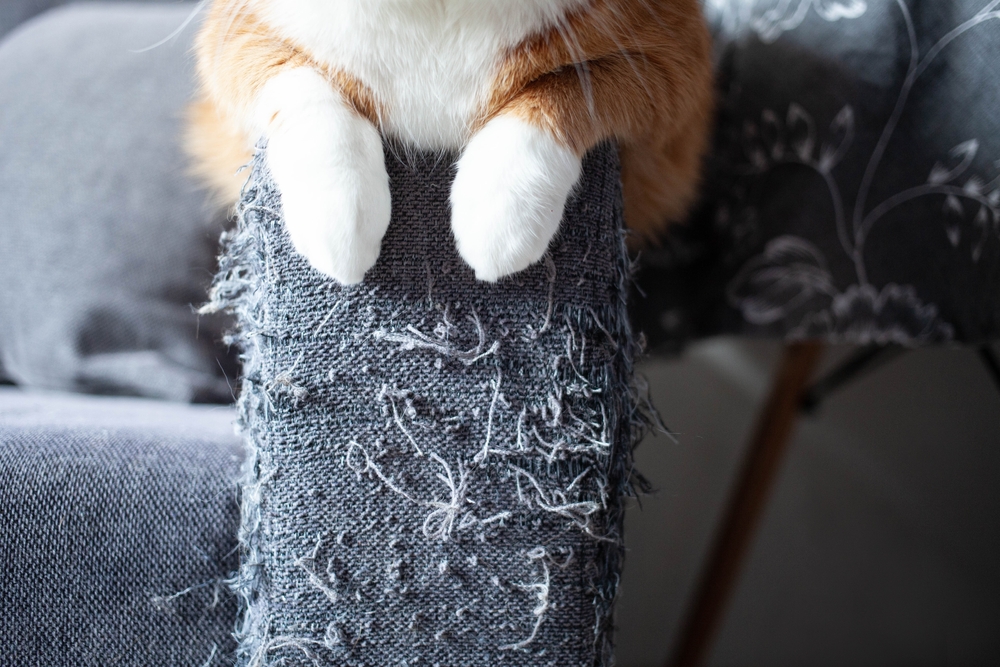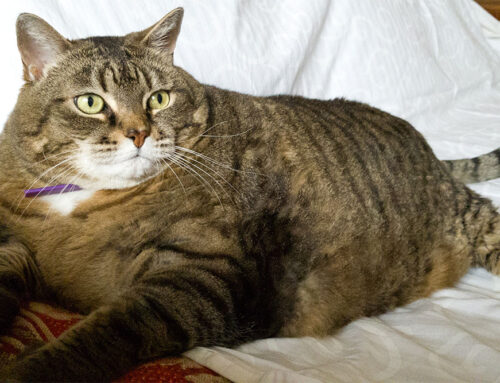Cats’ destructive scratching is upsetting, but your whiskered pal isn’t doing this just to be a nuisance. Cats’ scratching is instinctual and necessary for their mental and physical wellbeing. Our Bayview Animal Hospital team wants to ensure destructive scratching doesn’t affect the bond you and your feline friend share. Learn why your cat’s gotta scratch, and follow our tips to redirect their behavior and salvage your belongings.
Cats have their reasons
If your cat is scratching destructively, they aren’t doing it to annoy you. The behavior is important to their mental and physical wellbeing, serving many purposes such as:
- Maintaining their claws — Scratching helps loosen and remove the outer claw husk to keep the nail healthy and sharp.
- Stretching their forelimbs and spine — When a cat scratches, they seat their claws into a surface and extend their forearms and spine, stretching deeply. Doing so helps keep your whiskered pal fit and flexible for those crazy zoomy sessions.
- Marking territory — Cats have scent glands between their paw pads, and they deposit their scent when they scratch, marking their territory and communicating with other cats in the area.
- Relieving stress — Cats are sensitive to stress, and the most minor change in their environment can cause your whiskered pal to experience anxiety. Scratching is an upset cat’s go-to stress reliever.
- Preventing boredom — Bored cats often scratch destructively. Your cat needs mental and physical stimulation, and if these needs aren’t met, your feline friend may resort to destructive scratching for entertainment.
Cats can be reasonable
About some things, anyway! Most cats will use scratching posts if they are easily accessible. Consider the following scratching post factors:
- Number — Cats like to have choices, so provide several scratching posts throughout your home. If you have multiple cats, ensure you provide enough for each one.
- Orientation — Some cats like to scratch vertically, while others prefer to scratch horizontally. If your cat routinely scratches upholstered chair backs and curtains, they are a vertical scratcher. If your whiskered pal usually scratches your carpet or rug, they are a horizontal scratcher. Ensure the scratching posts you provide your cat meet their scratching preferences, and offer them multiple scratching orientations.
- Surface — Scratching posts come in many surface types such as cardboard, sisal, carpet, and wood. To determine which scratching surface type your cat prefers, offer them several options.
- Sturdiness — Ensure scratching posts are stable. If a post topples over when your cat tries to use it, they may become frightened and avoid the scratcher.
- Location — Place scratching posts in areas where your cat enjoys spending time. If you place scratchers in out-of-the-way areas, your feline friend is unlikely to use them.
Cats may need a perspective change
If your cat has become accustomed to scratching inappropriately, you may have to redirect their behavior. To encourage your whiskered pal to scratch appropriately, follow these tips:
- Making scratching posts tempting — Place catnip or a favored toy on the scratching post to help attract your cat’s attention.
- Making furniture unpleasant — Use double-sided sticky tape on areas where your cat tends to scratch to dissuade them from scratching destructively.
- Blocking their access — Use a scratching post to block your cat’s access to an area where they like to scratch inappropriately.
- Cleaning the area — Many cats return to the same scratching location because they recognize their scent. Use an enzymatic cleaner on the area where your feline friend has been scratching destructively.
Cats may need additional incentives
In addition to redirecting your whiskered pal’s destructive scratching behavior, you can take other steps to help them learn to scratch appropriately. To help suppress your cat’s destructive scratching, follow these tips:
- Trim your cat’s nails every 10 to 14 days.
- Place vinyl caps on your feline friend’s nails.
- Spray your furniture with cat repellent.
- Use a pheromone plug-in to help keep your cat calm.
- Play with your cat at least 10 to 15 minutes twice a day to keep them physically and mentally engaged.
- Use boredom-prevention techniques such as providing vertical climbing spaces and window perches, rotating their toys, and feeding your feline friend with a food puzzle toy.
- Don’t punish your cat for destructive scratching. This will only increase their anxiety and worsen the problem.
Cats deserve spa treatment

Trimming your cat’s claws helps preserve your belongings and also helps prevent painful ingrown nails. To trim your whiskered pal’s nails, follow these tips:
- Gather your supplies — You need a cat-specific nail trimmer, treats, and styptic powder. You may also need a helper and a towel, depending on your feline friend’s temperament.
- Stay calm — Your cat can sense your anxiety, and they may hide if you express your nervousness.
- Restrain your cat — Find a comfortable way to restrain your cat effectively. This is different for each cat. Some do well sitting in your lap, while others need to be wrapped in a towel. Determine the best option for your feline friend.
- Expose the claw — Apply gentle pressure to your cat’s paw pad to expose their claw.
- Trim the claw — Trim the claw at a 45 degree angle, using firm, decisive pressure.
- Avoid the quick — If you cut too close to the paw, you can cut the sensitive quick area, which can bleed and cause your cat pain. If you cut the quick, apply styptic powder to help staunch bleeding. If your cat has white nails, avoid the pink area close to the paw. If your cat has dark nails, only cut a little at a time to avoid cutting the quick.
- Be conservative — Only cut a few claws at a time, so your cat doesn’t get upset or restless.
- Reward your cat — Pet your whiskered pal and give them a high-value treat after trimming their claws.
Your cat’s need to scratch is instinctual. To prevent destructive scratching, try to redirect their inappropriate behavior. In addition, by keeping your feline friend’s nails trimmed, they are less likely to scratch destructively. If your whiskered pal is less than cooperative for their claw-trimming session, contact our Bayview Animal Hospital team.







Leave A Comment